1
HARRY SNIDER & CO. (before clocks)Harry Snider was born in Winnipeg in 1910. After a short career as a commercial artist, he went to work for his sister and brother-in-law's clock company in the 1930s. Sarah was married to Leopold Stossel, the man who started the Blackforest Clock Company in Toronto in 1928 to sell imported German clocks in Canada. There Harry learned about both the general construction and the sale of clocks. He was listed in the 1940 and 1942 business directories for Toronto as a salesman for the Forestville Clock Company, the new company name that was created because of World War II.
Some time in the early 1940s Harry decided to set up his own business, which he called Harry Snider and Company, to purchase and sell various jewellery items at the wholesale level. This company was listed in the Toronto directories from 1943 to 1952. The offices were located on the third and then fourth floor at 229 Yonge Street in Toronto. By 1950 he was seriously considering setting up his own clock company.
We are aware of two versions of jewellery music box sold under his Harry Snider & Co. name. One that now turns up occasionally is shaped like a miniature grand piano (Picture 2 in this Storyline). It is made with a small, spring-driven Swiss music box, colourful marbleized plastic lid, and gold-painted metal frame, and includes wood, felt and paper components. Overall dimensions are 20 cm long X 13 cm wide X 10 cm high. The company name is rubber-stamped on the bottom as "Manufactured by HARRY SNIDER & CO, TORONTO, CANADA" (Picture 3).
THE SNIDER CLOCK CORPORATION (1950-1957)
The Snider Clock Corporation was set up by Harry Snider in 1950 to manufacture and sell several models of mantel and wall clocks that he designed . For a few years he remained at 229 Yonge Street in Toronto, where his wholesale jewellery company was located. By 1953 he had moved his clock production facilities to the second floor of the two-storey building at 466 Bathurst Street (Pictures 4 and 5).
The earliest mantel and wall models had china cases molded and hand-painted for him in Toronto. His "mantel" clock is shown in Picture 6, his Birdhouse wall model in Picture 7. A logo on the back of some cases proudly stated "Fine China", "WEDGEPORT", "HAND PAINTED" and "A BRITISH EMPIRE PRODUCT". Harry installed spring-driven, 8-day, balance-wheel clock movements, some with an alarm clock function, that he obtained from the Ingraham Clock Company. That American company had its Canadian factory for Ingraham Canadian in Toronto. Starting around 1952, versions of some clock models were available with electric motors. Although a small number of motors were purchased initially from Smiths in England, most were imported unassembled from Lanshire Electric in Chicago for many years.
Some models of mantel clock were available with matching lamps (Picture 8). In competition with other North American companies, Snider introduced serveral styles of mantel clock based on horses (example in Picture 9) and boats (Picture 10). And to meet the growing demand for television lamps in the 1950s, Harry designed and manufactured many styles. Two are shown in Pictures 11 and 12. These TV lamp clocks were heavily promoted in the mid to late 1950s by the Snider family at the annual Toronto Gift Show where shop owners would select new products for sale (Pictures 13 and 14). You can learn more about TV lamps and Harry's various designs in a separate Storyline in this exhibit.
The early clock dials typically had the script word Snider below the 12 and SNIDER CLOCK CORPORATION, TORONTO, CANADA below the 6. For all Snider clocks up to the end in 1976 their script name Snider was always on the dial. Some representative examples of dials are shown in Pictures 15 through 21 covering both companies up to the 1970s.
The earliest Snider starburst clocks were introduced in the mid 1950s, models with glass-covered dials and brass-plated metal rays (Picture 22). Elaborate designs that included wood rays came later.
Harry's older son, Gary, joined the company in 1956. He started working in the factory, learning each aspect of production, and then travelled throughout Ontario as a salesman.
No catalogues have been found yet for the Snider Clock Corporation's broad range of clock models available in the 1950s.
THE SNIDER CLOCK MFG CO. LIMITED (1957-1976)
The company name was changed in 1957, for beneficial tax reasons. By about 1960 the production of mantel and TV lamp clocks had been phased out in favour of focusing on the growing consumer market for wall clocks.
Harry was ready to compete with several of his own models of so-called "atomic" clocks characteristic of the years from 1957 to the early 1960s. These ball-and-stick clocks, made by several American companies as well, represented electrons circling around the nucleus of an atom. This style may well have been triggered by the Soviet launch of the first man-made satellite, Sputnik.
The starburst/sunburst generic style was becoming very popular in homes. The brass-plated, metal-rod rays approach with glass-covered dials gradually changed by about 1960 to open dials and dozens of combinations of wood and metal rays. In addition to the electric motor version for Snider wall clocks, a battery-assisted electromechanical balance-wheel movement was available as an option. Because of relatively high energy consumption, these early battery clocks requires a large C or D cell. The advantage of the battery movement was greater flexibility in placing the clock on a wall in the home. An unsightly electrical cord hanging down to the outlet near floor level was no longer necessary!
Production facilities were moved from Bathurst Street to 12 Brant Street in Toronto in 1966 or early 1967. A view of that building as it appeared in October of 2007 is shown in Picture 24, with Michael Snider's floor plan sketch (again from memory) in Picture 25.
Harry Snider continued to create new models, and then develop production jigs for them (Picture 26). Every year there was a new, undated catalogue promoting the latest models. It was always accompanied by an English (Picture 27) or bilingual (Picture 28) cover letter proudly announcing to shop owners the benefits of stocking top quality, original models of clock made in Canada. At the back of each catalogue was the guarantee (often biligual, Picture 29) that stated "Every SNIDER clock is made of the finest quality materials, and is thoroughly tested at our factory for excellence and accuracy, that is your assurance of its dependability and satisfaction." An early/mid 1960s cover is shown in Picture 30. The 1960s catalogue covers had the words HOUSE OF SNIDER inside a shield outline (Picture 30), and Harry's cover letters referred to "Canada's largest manufacturer of modern and decorator clocks, designed to appeal - and to sell."
The second company's name was rubber-stamped on the back of the motor can from the late 50s into 1960s (Picture 31). Later in the 1960s a clear-back, stick-on printed label was used (Picture 32). Finally there was a printed white label in the early 1970s (Picture 33).
In the 1960s Snider produced a huge variety of starburst and other wall clock designs. Five representative examples are shown in Pictures 34 to 38. More that a hundred of them are shown in the Gallery, and dozens are highlighted in the Storyline "The Evolution of Snider Wall Clock Designs 1950 to 1976".
From the mid 1950s onward, most clock models were identified by numbers rather than names. However, a few large wall clocks such as the Scandia and the wide panel clocks were given model names (for example, The South Winds and The Chariot).
Harry Snider passed away in September of 1972. His younger son Michael, who had been Vice President and Junior Partner since 1969, took over the business operations. New models, including many "novelty" clocks, and new production methods were developed by Michael for the early 1970s. These clocks were promoted in catalogues filled with pictures of a broad mix of designs, including a few updated starburst models from the 1960s. Business continued to be very good up to 1976.
THE END OF SNIDER CLOCKS (1976)
By 1976 the U.S.-based Bulova Watch Company had brought out their Caravelle line of wall clocks. To be able to continue selling profitable Bulova watches, store owners had to agree to puchase $10,000 worth of Caravelle clocks, under very generous payment terms. Sadly, the sales power of such a large company meant that, within a few months, the smaller stores across Canada that had been selling Snider clocks for many years were no longer able to support the Canadian company, even with its many attractive new models. And so the Snider family business, that in its heyday had up to twenty employees and sold 50,000 clocks each year, was forced to close.
POSTSCRIPT
This Community Memories exhibit about Snider clocks serves several purposes. Foremost is documenting the interesting story of the Snider family's Canadian clock businesses that competed very successfully for twenty-six years against much larger international companies. Michael Snider has indicated his sincere appreciation on behalf of himself, his family, his late brother Gary, and especially his late father Harry.
We have not yet been able to contact any surviving former Snider employees from at least thirty years ago. However, we are pleased to honour their contributions to the success of the "House of Snider". If any happen to be reading this story, we would sincerely appreciate hearing from them.
In addition, we trust that our comprehensive online presentation of the Snider companies' history, and extensive gallery of more than one hundred examples of Snider clocks covering the entire production period, will assist the many owners and collectors of Snider clocks. We welcome feedback through our web site at www.canclockmuseum.ca. Allan Symons
2
Harry Snider & Company jewellery music box, 1940smid/late 1940s
The Canadian Clock Museum, Deep River, Ontario
 Credits:
Credits:The Canadian Clock Museum
3
The stamped ink label on the bottom of Harry Snider's piano-shaped jewellery music box.mid/late 1940s
The Canadian Clock Museum, Deep River, Ontario
 Credits:
Credits:The Canadian Clock Museum
4
The first Snider factory location in Toronto, 466 Bathurst Street.Photo December 2005
First location Snider clock factory, 466 Bathurst Street, Toronto
 Credits:
Credits:The Canadian Clock Museum
5
Floor plan of Bathurst Street Snider factory, sketched from memory by Michael Snider.Sketched March 2005
First location Snider clock factory, 466 Bathurst Street, Toronto
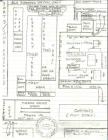 Credits:
Credits:Michael Snider
6
The powder blue version of Harry Snider's early china-cased mantel clock.early to mid 1950s
The Canadian Clock Museum, Deep River, Ontario
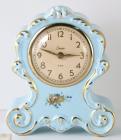 Credits:
Credits:The Canadian Clock Museum
7
Green roof example, Snider Clock Corporation's china-cased birdhouse wall clock (windup movement).early to mid 1950s
The Canadian Clock Museum, Deep River, Ontario
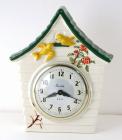 Credits:
Credits:The Canadian Clock Museum
8
Light green horse mantel clock (windup) with matching lamp stands, Snider Clock Corporation.mid 1950s
The Canadian Clock Museum, Deep River, Ontario
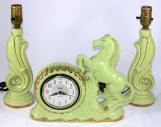 Credits:
Credits:The Canadian Clock Museum
9
Gold horse and horseshoe with electric clock on wood base, Snider Clock Corporation.mid 1950s
The Canadian Clock Museum, Deep River, Ontario
 Credits:
Credits:The Canadian Clock Museum
10
Rigged three-masted boat electric mantel clock with small lights, Snider Clock Corporation.mid 1950s
The Canadian Clock Museum, Deep River, Ontario
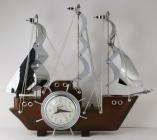 Credits:
Credits:The Canadian Clock Museum
11
Black panthers electric TV lamp clock, Snider Clock Corporation.mid 1950s
The Canadian Clock Museum, Deep River, Ontario
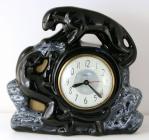 Credits:
Credits:The Canadian Clock Museum
12
Turquoise version, model 503 metal TV lamp electric clock, Snider Clock Mfg. Co.late 1950s
The Canadian Clock Museum, Deep River, Ontario
 Credits:
Credits:The Canadian Clock Museum
13
The Snider company often had a booth at the annual Toronto Gift Show.ca. 1960
Toronto Gift Show
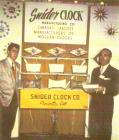 Credits:
Credits:Michael Snider
14
The Snider family promoting their clocks at the 1956 Toronto Gift Show.1956
Toronto Gift Show
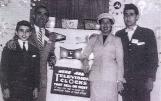 Credits:
Credits:Michael Snider